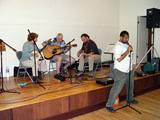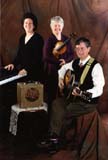Traditional American Contra & Square Dance Workshops Traditional American Contra & Square Dance Party American Contra Dance (also contradance, contra-dance and other variant spellings) refers to several folk dance styles in which couples dance in two facing lines of indefinite length. Contra dances can be found around the world, though they are especially popular in the United States. Contra dance is also referred to as traditional New England folk dance. A contra dance evening may include a few dances of other types including: Traditional American Squares, waltz, polka, schottische, swing, rounds, clogging, Hambo and other Scandinavian, and other types of couple dancing. Traditional American Square Dance is a catch-all term for styles of square dance that are not within the genre of modern Western square dance. This includes the regional styles that existed before the middle 1950s (when modern the Western style began to emerge as a new standard as figures and calls were standardized, regional differences were eliminated and new figures and calls were created); or styles that have survived or have been revived since the middle 1950s. In some communities in the United States and Canada, there are dance events consisting primarily of traditional squares, sometimes alternating with other styles of partner dancing, such as contra dance, round dance, mixers, waltzes, Scandinavian dance, Cajun/Zydeco dance and/or country/western dance. Square dance callers who call for occasional dancers, beginning-level dancers or brand-new dancers primarily use calls and figures from traditional square dance. |
|
Instructors & Musicians |
|
Roger Diggle (Madison, Wisconsin), to his astonishment, has been calling dances for about eighteen years. One of the most widely traveled of the Midwest's callers, Roger has called dances in more than 25 states. He is known for his careful dance selection, efficient teaching, and musical calling. He has composed dances that have made their way throughout the U.S. Roger is also an accomplished dance musician, and has played for dancing with a wide assortment of musicians. He has a particular interest in using guitar as accompaniment to Northern-style dance music. An unusually good whistler, Roger can, by himself, produce reasonable dance music and call the dance at the same time, all without ever touching an accordion. He has been a staff caller and musician at camps and festivals from coast to coast. Many dancers, callers, and musicians have enjoyed and benefited from Roger's workshops, and from discussions he has led on various aspects of dancing, calling, choreography, making dance music, and dance organizing. Roger serves on the Executive Board of the Country Dance and Song Society. |
 |
Paul Collins (Chicago, IL), has danced since the age of eight and has been an ethnic folk dance leader & square/contra dance caller since high school. Paul has been a guest caller at dances from the North Country to the Deep South and has even called squares and taught folk dancing for the hearing impaired at Gallaudet University in Washington. DC. Paul led the University of Chicago Folk Dance Club for many years and introduced squares and contras into the group's repertoire. After directing the U of C Folk Dancers' Annual Fall "International Folk Festival" for twelve years, Paul joined Gerhard Bernhard in producing the DCFF and two years later became co-director. In 1989, Paul and Bill Sasso started the Mid-North Folk Dance Club that has today evolved into Ethnic Dance Chicago (www.ethnicdance.net)and Ethnic Dance Connection (www.ethnicdance.org). Through "Connections", Paul presents dance programs for kids in primary and secondary schools, tutoring programs and scouting organizations. Paul does annual weeks in residency at the Spring Hill Middle School (Wisconsin Dells, WI), and the Chaney Monge School (Crest Hill, IL) helping the middle school classes prepare ethnic dance presentations for their school's International Festivals and Multi-Cultural Fairs. In the world outside of dance, Paul is an independent consultant in interpersonal communications strategies, is a thought leader in facilitating group interaction and collaboration on the web, was a co-founder and director of the Midwest Facilitators' Network, and is active in the Chicago Chapter of the International Association of Facilitators. |
 |
The Last Gaspé (Madison, WI) is a New England-style contra dance band that plays Canadian, Irish and American fiddle music that swings. The band blends traditional forms with contemporary innovations to create an infectious, exciting sound. The band features John Kraniak (guitar), Amy McFarland (piano), Maria Terres (fiddle), and Kevin Clark (bass). Founded in 1987, they have played for dances and folk festivals throughout the U.S. The musicians come from very different backgrounds, ranging from self-taught to conservatory trained. They all share a love of dancing, so while they aim to be more innovative, they respect tradition and strive for danceability throughout their music. Their wide-ranging musical influences range from Count Basie to Michael Coleman to the Grateful Dead. Some of these influences show up in their approach to melody and some in their treatment of rhythm. While they don't play jazz, they take a jazz approach to playing, stressing improvisation, musical interplay and a solid ensemble sound. |
 |